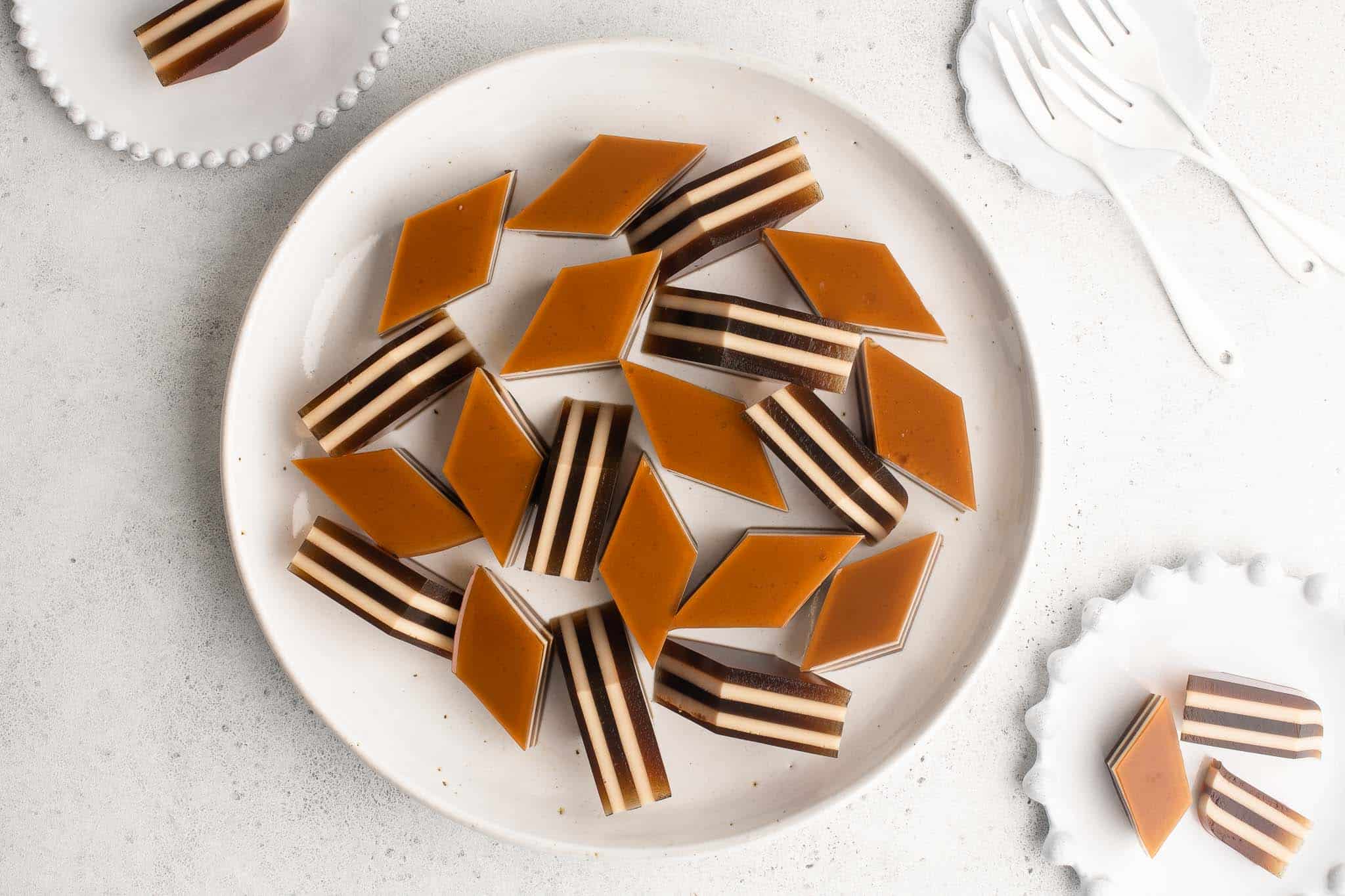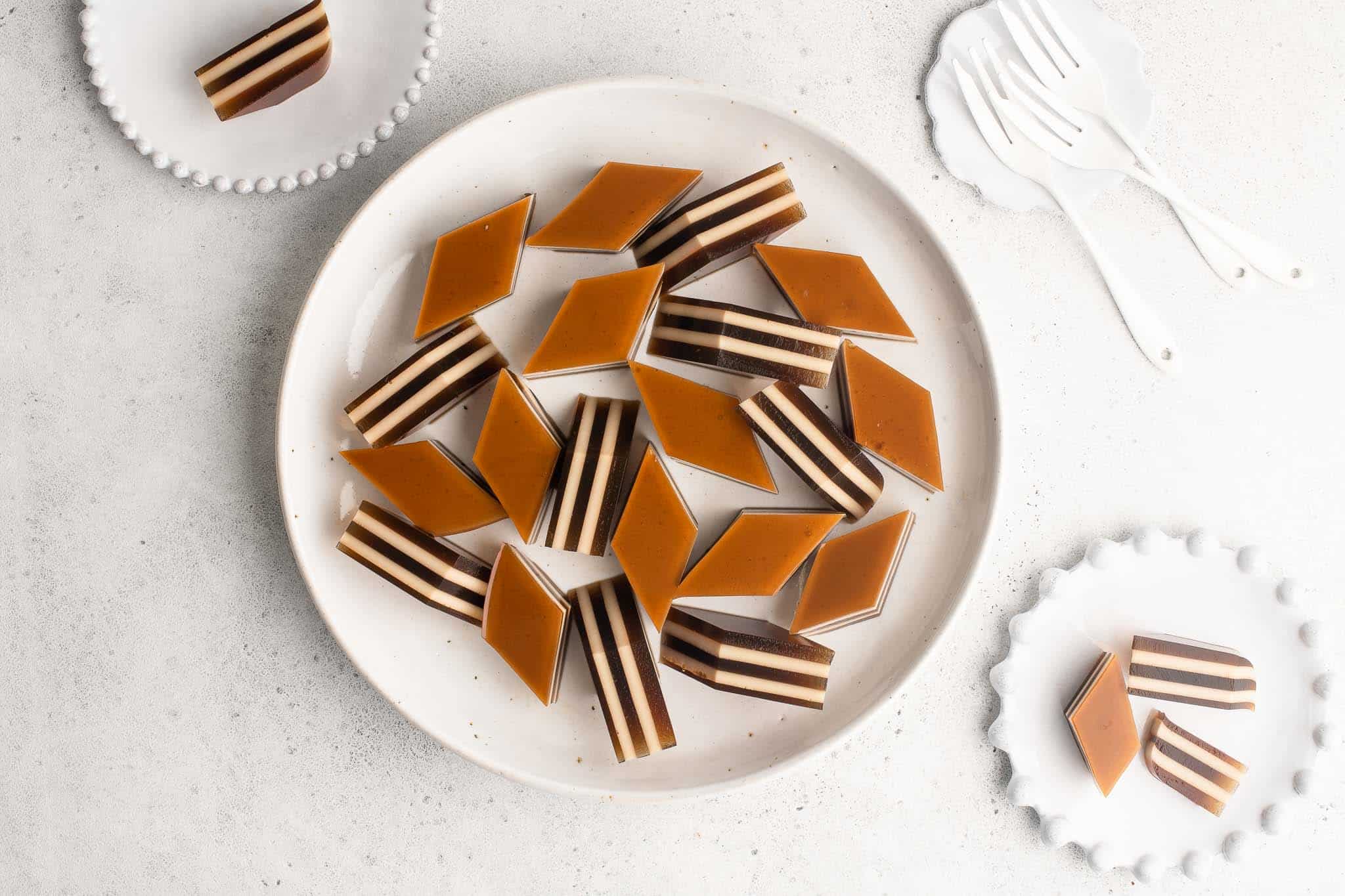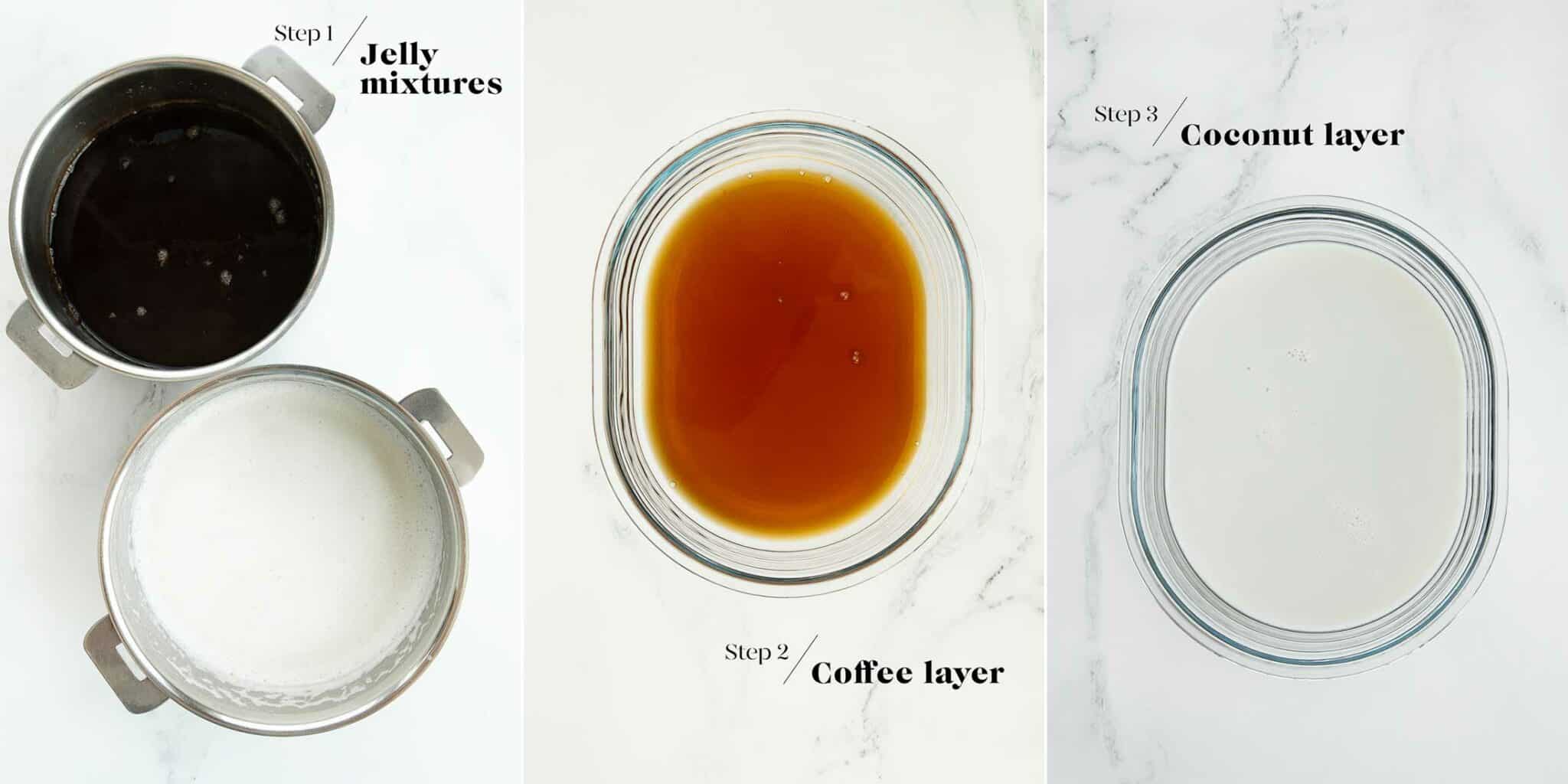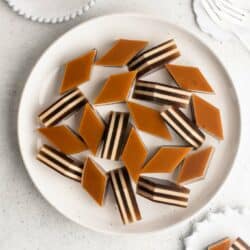A refreshing and tasty Vietnamese Coffee Jelly, the perfect end to any meal. Recipe with step-by-step photos.

Vietnamese Coffee Jelly
Summers in Switzerland have gradually become more hot and humid, sometimes so unbearably so that it is hard to think of it as a country where it also snows in the winter months. One summer, I was trying to think of what dessert I could bring to a picnic with friends, one which was also vegan and gluten-free.
Suddenly, I remembered that my mother used to make this Vietnamese Coffee Jelly (or Thạch Rau Câu Cà Phê Sữa) when I was younger, which led me on a years-long journey in experimenting with all sorts of Vietnamese jelly recipes.
Vietnamese Desserts
I can’t quite remember if I was a fan of Vietnamese jellies growing up … probably not. My parents ran a Vietnamese bakery in Australia, so I had unlimited access to Cream Buns, Finger Buns, Lamingtons and the like. When you are constantly surrounded by Australian and French-style cakes and pastries, it’s hard to make room for the Asian desserts.
But now that I am older, I find myself craving the Asian desserts of my childhood, even if I did not eat them that willingly back then. Perhaps as an adult, I now appreciate the lower-sugar content and different textures in Asian desserts. Also, as I try to hold onto my roots and pass on traditions to my own children, I feel I need to continue the cycle of introducing Asian desserts to my kids. They are, actually, very delicious! (I should have listened to my mum back in the days …)
What is Vietnamese Coffee Jelly?
Vietnamese Coffee Jelly is comprised of alternating layers of strong Vietnamese coffee and coconut milk. Both layers combine to give a striking dessert which is very popular in Vietnamese cuisine. In fact, this method is employed for other flavours of Vietnamese jellies too, most notably Vietnamese Coconut and Pandan Jellies.
Vietnamese jellies are made using agar agar, which is a plant-based gelatin derived from seaweed. So unlike Western-style jellies, which are typically soft and wobbly in texture, Vietnamese jellies made with agar agar are quite firm and almost crunchy in texture.

Vietnamese Coffee Jelly Recipe
A hallmark of a well-executed Asian dessert is that it is “not too sweet”.
I have tinkered with many recipes for Vietnamese Coffee Jelly over the last few years, ultimately arriving at what I think is the right balance between a strong and bitter coffee layer, against a sweet but “not too sweet” coconut layer.
But as everyone’s tastes and palates differ, you may need to adjust the recipe to suit your preferences too.
For the coconut layer, I have added sweetened condensed milk as a nod to the classic Vietnamese Coffee. However, if you need to make this recipe vegan, either substitute with sweetened condensed coconut milk (it tastes exactly the same as sweetened condensed milk with barely a hint of coconut taste), or add more sugar to taste.
What Type of Coffee to Use for Vietnamese Coffee
If you have never made Vietnamese Coffee before, here is my recipe for Vietnamese Coffee, as well as tips and suggestions on what type of coffee to use.
For the Vietnamese Coffee Jelly, I simply use Nespresso coffee pods to make enough espresso required for the recipe.
You may have to experiment with the strength of the coffee. Many of my early attempts at this recipe produced a jelly where you could barely taste the coffee. As it is a coffee jelly, I think it is important to highlight the coffee flavour.

How to Make Vietnamese Coffee Jelly
Making Vietnamese Coffee Jelly is not necessary hard, but it is time consuming as you have to wait for each layer to set before proceeding with the next layer.
For this recipe, I like to make it the way my mother did, which is to use a glass serving dish; she used a brown glass Pyrex dish which I have forever associated with this Vietnamese Coffee Jelly.
It is also popular to make Vietnamese jelly using flower moulds, whether made from metal or silicone. You will have to follow similar steps as below, but the setting time will be shorter if you are using smaller moulds.
Step 1
Make both the coffee mixture and the coconut mixture at the same time.
Measure the water and agar agar into two large saucepans, and let the mixture stand for 10 minutes to allow the agar agar to bloom.
Add the remaining ingredients to each saucepan. Bring both saucepans to the boil, and allow the mixture to simmer for 5 minutes to activate the agar agar.
Turn the heat down to the lowest setting for each saucepan. You need to keep the mixture somewhat warm to prevent it from setting while you are assembling the jelly. During this time, whisk occasionally to ensure that the mixture is smooth.
Step 2
Pour two ladles of the coffee mixture through a fine mesh strainer into the serving dish. The strainer will remove any solids in the mixture, as well as reduce any bubbles.
Allow the coffee layer to set before proceeding with the next layer.
The setting time will depend on the size of your dish and the room temperature. But if you use a similar sized dish to mine (1.5 litres/6 cups), it should take about 6-8 minutes for each layer to set properly.
To check if the layer has set, gently move the dish to see how the jelly moves. If the mixture still wobbles, wait a bit longer. Once the jelly no longer moves in the dish, and a gentle touch of the jelly reveals that it is somewhat firm, you can proceed with the next layer.
Step 3
Repeat the steps described above for the coconut layer.
Step 4
Repeat the same steps for each layer, until all of the liquid has been used. Allow the jelly to set at room temperature, before covering with plastic wrap, and leaving it to set in the fridge for at least 4 hours or overnight.

Tips For Making Vietnamese Coffee Jelly
- Make both layers at the same time. Both the coffee mixture and the coconut mixture require similar steps, so save on time and make them at the same time (or one after the other).
- Use separate whisks. You will need to whisk both layers regularly to ensure a smooth mixture.
- Use the same size ladle for both layers. If you don’t have two ladles of the same size, simply wash them after each use. Using the same size ladle will ensure that your layers are all even in size.
- Use a glass serving dish. Show off the many layers of this dessert with a glass dish. Even if you don’t plan to serve the dessert in the dish (and to slice at the table), I find it helpful to see the layers when assembling the jelly.
- Use a timer. Once the first layer has set properly, make a note of how long it took, as this will be approximately how long it will take for each of the remaining layers to set. The jelly will have set properly if it doesn’t move or wobble in the dish. Also, if you touch the jelly gently, it should feel firm.
- Pour in a zig-zag motion. Even though a layer may look set, it is still quite fragile. To prevent disturbing the layer underneath, pour the next layer in a zig-zag motion all over the layer underneath. If you pour in just one place over the layer underneath, this can heat up the layer underneath, causing it to rupture.
- Don’t worry about mistakes. Sometimes, a layer will rupture even though it looked properly set. Don’t worry too much. It may only affect a small part of the whole dish. In any event, the finished product will still taste delicious!
How to Serve Vietnamese Coffee Jelly
This Vietnamese Coffee Jelly is best served cold, straight from the fridge.
I like to slice it at the table as I am serving, but you can also pre-slice the jelly before serving. It is traditional to cut the jelly into diamond shapes, but you can cut any shape you like.
Once the jelly has been out of the fridge for some time, and also after 1-2 days in the fridge, the layers will start to bleed into each layer. Or, rather, the coffee layer will start to penetrate the coconut layer, so that the coconut layer will no longer be a bright white colour.
I think this Vietnamese Coffee Jelly is best eaten within 1-2 days.
Print
Vietnamese Coffee Jelly
- Prep Time: 1 hour
- Cook Time: 10 mins
- Total Time: 1 hour 10 minutes
- Yield: Serves 6 to 8
- Category: Dessert
- Method: Stove Top
- Cuisine: Vietnamese
A refreshing and tasty Vietnamese Coffee Jelly, the perfect end to any meal. Recipe with step-by-step photos.
Ingredients
For the Coffee Layer
- 450 ml water
- 6 g (2 teaspoons) agar agar
- 100 g (1/2 cup minus 1 tablespoon) caster sugar (superfine sugar)
- 125 ml (1/2 cup) espresso or other strong coffee
For the Coconut Layer
- 450 ml water
- 6 g (2 teaspoons) agar agar
- 45 g (1/4 cup minus 1 tablespoon) caster sugar (superfine sugar)
- 5 tablespoons sweetened condensed coconut milk or sweetened condensed milk
- 125 ml (1/2 cup) coconut milk
Instructions
For the Coffee Layer
- Measure the water and agar agar into a large saucepan.
- Leave the mixture for 10 minutes to allow the agar agar to bloom.
- Add the remaining ingredients.
- Whisk everything together until all of the ingredients are combined.
- Bring the mixture to a boil over medium-high heat.
- Let the mixture simmer for 5 minutes to activate the agar agar. Keep a careful watch on the saucepan as the mixture may rise and boil over.
- Turn the heat down to the lowest setting on your stove.
- As the mixture sits, it may start to set in places. Whisk the mixture from time to time so that you have a smooth and clear mixture.
For the Coffee Layer
- Measure the water and agar agar into a large saucepan.
- Leave the mixture for 10 minutes to allow the agar agar to bloom.
- Add the remaining ingredients.
- Whisk everything together until all of the ingredients are combined. Make sure you use a separate whisk for the coffee layer.
- Bring the mixture to a boil over medium-high heat.
- Let the mixture simmer for 5 minutes to activate the agar agar. Keep a careful watch on the saucepan as the mixture may rise and boil over.
- Turn the heat down to the lowest setting on your stove.
- As the mixture sits, it may start to set in places. Whisk the mixture from time to time so that you have a smooth and clear mixture.
To Assemble the Vietnamese Coffee Jelly
- Use a serving dish of your choice. I like to use a glass serving dish so you can see the layers on the side. For this recipe, I use a serving dish with a capacity of 1.5 litres/6 cups.
- Pour two ladles of the coffee mixture through a fine mesh strainer into the serving dish. The strainer will remove any solids in the mixture and it will also help to remove any bubbles.
- Let the coffee layer set before proceeding with the next layer. However, you can’t leave it to set for too long, otherwise the next layer will not stick to it. To check the progress of the jelly setting, gently tap the dish to see if the mixture has set all over, especially in the centre. Once you see that the mixture is no longer wobbly in the dish, and a gentle tap on top of the jelly reveals that it is no longer liquid underneath, you can proceed with the next layer. The setting time will depend on the size of your dish and the room temperature. For my dish, each layer takes 6-8 minutes to set.
- In the meantime, wash the ladle and strainer, unless you happen to have two of both. For the layers to be equal in size, you need to use the same size ladle.
- Pour two ladles of the coconut mixture through a fine mesh strainer on top of the coffee layer. I recommend doing this slowly and to pour in a zig-zag motion all over the bottom layer; if you pour the mixture just in one place on top of the bottom layer, you risk warming up the bottom layer and rupturing it.
- Let the coconut layer set before repeating the above steps, alternating between the coffee mixture and the coconut mixture.
- Once the top and final layer has set, cover the dish with plastic wrap, and place the dish in the fridge.
- Let the jelly set in the fridge for at least 4 hours or overnight.
To Serve
- It is traditional to serve this jelly cut into diamond shape pieces, but you can slice them how you wish.
- Serve the jelly cold from the fridge.
Kitchen Notes
 STORAGE
STORAGE
Store the Vietnamese Coffee Jelly in the fridge, and it should be consumed within 1-2 days.
 OVEN & STOVE TEMPERATURES
OVEN & STOVE TEMPERATURES
All recipes on this website have been tested on an induction stove and/or with a conventional oven (i.e. an oven without fan). All recipes on this website use temperatures for a conventional oven, unless otherwise mentioned. Convection ovens (i.e. fan-forced ovens) are typically 20°C/70°F hotter than conventional ovens, but please check your manufacturer’s handbook.
 CONVERSIONS
CONVERSIONS
To convert from cups to grams, and vice-versa, please see this handy Conversion Chart for Basic Ingredients.
 Print
Print Pin Recipe
Pin Recipe Rate
Rate
I wanted to make this as soon as I saw your recipe. I hadn’t eaten this jelly since I was a child and your recipe was totally spot on. Eating this jelly brought back so many memories! Such a wonderful recipe!